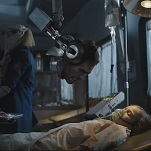Fringe: “Brown Betty”

How you felt about tonight’s offbeat noir/fairy-tale/musical Fringe might just depend on whether you cared even the slightest bit about the story-within-the-story. After all, we’re at a crucial point in Fringe’s master-narrative right now, with shape-shifters from Earth-2 on the cusp of spearheading an invasion, and Peter on the lam after learning that Walter stole him from his Walternate. With all that going on, what are we supposed to make of “Brown Betty,” a fanciful bit of what-if that advances the main plot only modestly (if at all)?
Well, we could look at it the way it was intended: as a diverting hour of television spent with a handful of likable fictional characters. Or to put it the way Alan Moore would: "This is an Imaginary Story… Aren’t they all?"
Let’s dispatch the framing device of “Brown Betty” straight away, since it has very little to do with the actual episode. While Walter frets over where Peter might be, he takes some deep hits from his bong, listens to Yes, and commences to makin’ labels. Right then, Olivia drops off her niece Ella with Astrid at the lab so that she can continue the Peterquest. Later Olivia returns to retrieve Ella and tells Walter that she had no luck finding Peter. Then Astrid drives Walter home, while across the street, September watches, and calls in to his superiors that Walter “does not remember my warning… yes, I am concerned too.” So that’s all there is to add to next week’s “Previously on Fringe.”
In between all that, Ella asks Walter to tell her a story, and he responds with a sweetened hodgepodge of Raymond Chandler and his own life, with all the science-fiction elements and “humans as machines” thematic play that makes Fringe Fringe. In Walter’s Tale, Olivia is a private eye, hired to find one Peter Bishop, who stole a glass heart from his scientist boss Walter Bishop. (No relation, just like in real life.) With the help of her assistant Esther Figglesworth—Walter’s intentional butchering of Astrid’s name—Olivia delves into a conspiracy that involves evil corporation Massive Dynamic and a cadre of raygun-carrying bald freaks known as “The Watchers.” (I liked how the Fringe writers paid homage to The Observers’ Marvel comics origins there.)
When Olivia sticks her nose in too far, Nina Sharp has her boxed up and dumped in the drink, where she’s rescued by Peter, who takes her back to the house he’s squatting in and shows her a map with 147 pins, each representing a child injured by his old boss Walter. Seems the kindly, wheelchair-bound Walter, who invented bubblegum, flannel pajamas, rainbows and singing corpses (“Why not bring a little life to the death, I say?”), stole all those ideas from children’s dreams, and replaced them with nightmares. And while he claims that Peter stole his heart, in fact he stole Peter’s.
There were times when I liked the idea of “Brown Betty” more than the actual episode. I found the who-has-who’s-heart? business a little cloying, and aside from the scene of Dunham P.I. almost drowning, I can’t say that I was ever on the edge of my seat. But director Seith Mann (who’s a rising star on the TV scene, having already helmed strong episodes of The Wire, Friday Night Lights and Sons Of Anarchy) gave the fantasy material a lovely burnished look and throwback snap. And though I have nothing against musicals per se, I was glad that this episode was less of a full-blown musical and more of a weird head-trip with occasional snatches of songs. (For those keeping score at home, we heard Walter sing a little bit of Tears For Fears’ “Head Over Heels,” Broyles sing some of Traffic’s “Low Spark Of High-Heeled Boys,” Astrid/Esther sing “I Hope I Get It” from A Chorus Line, corpses sing the kiddie classic “Candy Man,” and in a quiet, moving moment, Olivia sing “For Once In My Life,” previously performed by Stevie Wonder, among others.)
I also loved the inventiveness of Walter’s fantasy world, where everyone dressed in their ‘40s finest but still used cell phones and laptops, and where Walter himself worked in a crazy day-glo lab next to a polka-dot cow. It was good to see a little more of Broyles than usual too, as well as Massive Dynamic’s lab tech Brandon as a patent clerk (who really wants to work at MD) and William Bell as a crudely animated avatar on Nina Sharp’s video-screen.
Was I emotionally involved with Walter’s Tale? At times, very. I really enjoyed seeing the fictional Peter flirt with the fictional Olivia—him with his jazz and tough-talk, her with her pajamas and Veronica Lake hair-swoop. I liked the reverse-Operation gag when Olivia tried to revive the heartless Peter. (I confess I hadn't previously made the connection to Real Walter botching the heart-removal in his game of Operation with Ella earlier.) And though I wouldn’t say I was touched by Ella’s insistence on a happy ending, I did think it added a necessary layer to the episode, making it about more than just killing time before the season finale. On a meta-level, “Brown Betty” asks what constitutes a proper story. And on a this-really-does-matter-to-the-show level, the episode continues Fringe’s notion of multiple realities, and that idea that Godlike creators can dart between them, looking for a way to make a messy life come out more like something from a children’s book.







































